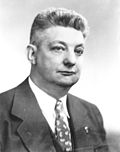| |||||||||||||||||
| |||||||||||||||||
 County results Cooper: 50–60% 60–70% 70–80% 80–90% Underwood: 50–60% 60–70% 70–80% 80–90% | |||||||||||||||||
| |||||||||||||||||
| Elections in Kentucky |
|---|
 |
The 1952 United States Senate special election in Kentucky was held on November 4, 1952, to complete the unexpired term of the late Senator Virgil Chapman. Interim Senator Thomas R. Underwood ran to complete the term but was defeated by Republican former Senator John Sherman Cooper.

